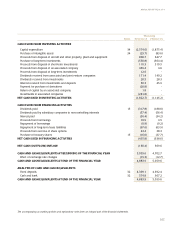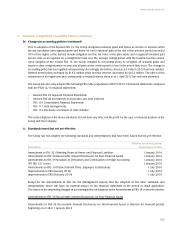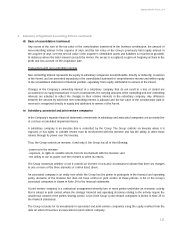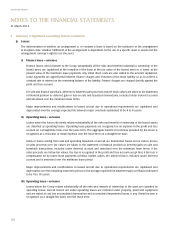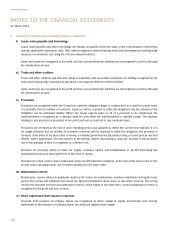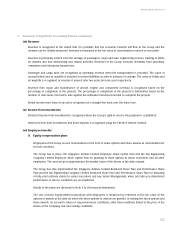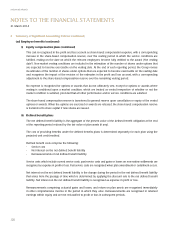Singapore Airlines 2014 Annual Report Download - page 119
Download and view the complete annual report
Please find page 119 of the 2014 Singapore Airlines annual report below. You can navigate through the pages in the report by either clicking on the pages listed below, or by using the keyword search tool below to find specific information within the annual report.
117
ANNUAL REPORT FY2013/14
2 Summary of Significant Accounting Policies (continued)
(k) Inventories
Inventories are stated at the lower of cost and net realisable value. Cost is determined on a weighted average basis.
Net realisable value is the estimated selling price in the ordinary course of business less estimated costs necessary to
make the sale. Where necessary, allowance is provided for damaged, obsolete and slow moving items to adjust the
carrying value of inventories to the lower of cost and net realisable value.
(l) Financial assets
Financial assets are recognised on the statement of financial position when, and only when, the Group becomes a party
to the contractual provisions of the financial instrument. The Group determines the classification of its financial assets
at initial recognition.
When financial assets are recognised initially, they are measured at fair value, plus, in the case of financial assets not
at fair value through profit or loss, directly attributable transaction costs.
A financial asset is derecognised where the contractual right to receive cash flows from the asset has expired.
On derecognition of a financial asset in its entirety, the difference between the carrying amount and the sum of the
consideration received and any cumulative gain or loss that had been recognised in other comprehensive income is
recognised in the profit and loss account.
All regular purchases and sales of financial assets are recognised or derecognised on the trade date, i.e., the date
that the Group commits to purchase or sell the asset. Regular way purchases or sales are purchases or sales of
financial assets that require delivery of assets within the period generally established by regulation or convention in
the marketplace concerned.
(i) Financial assets at fair value through profit or loss
Financial assets at fair value through profit or loss include financial assets held for trading and those designated
upon initial recognition as fair value through profit or loss. Financial assets are classified as held for trading if they
are acquired principally for the purpose of selling in the short-term. This category includes derivative financial
instruments entered into by the Group that are not designated as hedging instruments in hedge relationships
as defined by FRS 39. Derivatives are also classified under this category unless they are designated as effective
hedging instruments. Gains or losses on financial assets held at fair value through profit or loss are recognised in
the profit and loss account.
Assets in this category are classified as current assets if they are either held for trading or are expected to be
realised within 12 months after the end of the reporting period.
(ii) Loans and receivables
Non-derivative financial assets with fixed or determinable payments that are not quoted in an active market are
classified as loans and receivables. Such assets are carried at amortised cost using the effective interest method,
less impairment. Gains and losses are recognised in the profit and loss account when the loans and receivables
are derecognised or impaired, as well as through the amortisation process.


